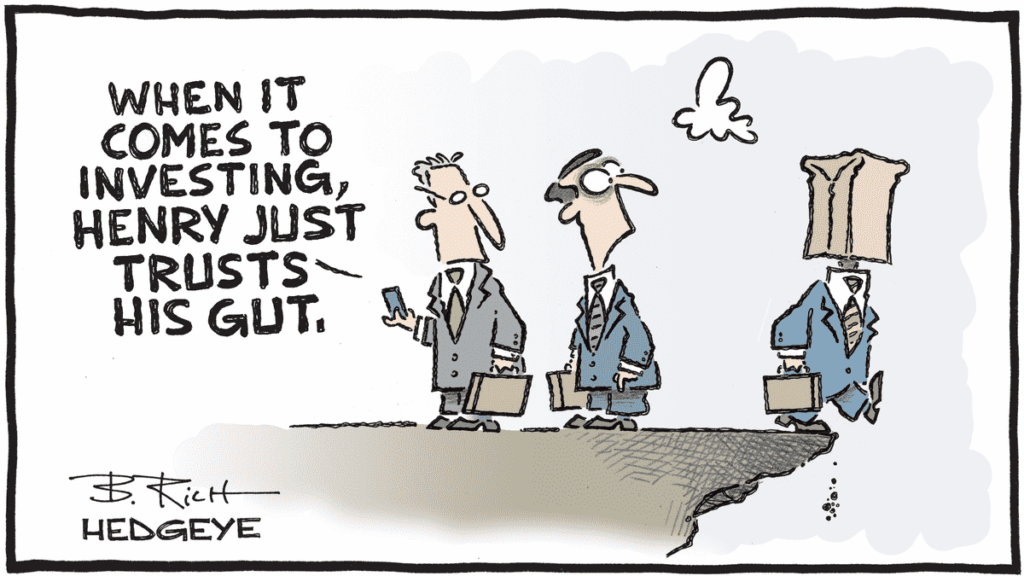
And here we go again! Not only are we kicking off a brand new week this morning, but we’re also starting a brand new month! We’ve just wrapped up May, which turned out to be the best May since 1990 – meaning that PERSONALLY, I’ve never experienced a better May, since I only set foot in this business in 1992. And that also means that the good old saying “Sell in May and go away” can pretty much be thrown out the window, because it clearly doesn’t apply anymore. Well… unless you consider that it’s based on the performance from May to November — and given what we’re seeing right now, we can’t rule out a bit more shaking ahead!
Sell in May and go away… UNTIL November
Yes, because technically, the “Sell in May and go away” theory assumes that you sell everything in May and BUY BACK EVERYTHING in November. So before we start acting smug and claiming that everything’s changed just because the Nasdaq gained 6.32% or the semiconductor sector exploded by 8.21%, let’s take a step back. Let’s not forget that the chicken currently residing in the White House is capable of absolutely anything — and we shouldn’t count our chickens before they’re hatched, plucked, tanned, and listed for sale on Vinted.
Yes, President Trump is still the most volatile element in global politics, and—tough luck—he also happens to lead the world’s most powerful economy. Which means: every post on Truth Social or X has the potential to throw markets into chaos.
And every time Trump issues a tariff moratorium, he has the incredible ability to change his mind before the end of it — usually well before, since technically, we haven’t actually seen the conclusion of a single one since the concept was invented. But it’s not just the moratorium chaos that can rattle the markets. Sometimes all it takes is Trump going full frontal on the Chinese — for example, calling them cowards and traitors (okay, cowards was my addition to spice up this morning’s drama). The point is: Trump claimed Friday night that China had betrayed the Geneva agreement. And this morning, we got the reply — and it’s safe to say that agreement is dead. If it was ever alive. Maybe stillborn is more accurate.
China Claps Back
So no, Trump isn’t just volatile when it comes to moratoriums. He’s perfectly capable of lighting fires on a whole range of topics. The problem now is that Wall Street doesn’t get rattled by tariff announcements anymore — they’ve become background noise. So new drama had to surface. And it has.
Tensions with China are taking center stage at the start of this week. Sure, there’s a lot of economic data coming over the next few days — but right now, let’s start with this: what began as trade talks between Trump and China has morphed into a full-blown verbal war that could definitely elevate market nervousness.
This morning, U.S. futures are under pressure, just like the Asian markets, because — and I quote — “tensions between China and the U.S. are heading back to the dark side of the Force.” On Monday, China had a full-blown diplomatic meltdown. Officially, it completely rejected the American accusation of violating the agreement. Worse: Beijing is accusing the U.S. of betraying the Geneva terms.
What triggered this shift? Washington went nuclear:
New restrictions on semiconductor design software,
Blocking certain chemical exports to China,
And to top it off: revoking student visas for Chinese nationals.
From Beijing’s perspective, this is now all about “unilateral provocations” and “destabilization of economic relations.” And to make matters worse, China has tightened its grip on rare earth exports — that essential ingredient for the global tech industry.
Trump’s Friday night social media outburst really pushed China over the edge. For those who missed it: he said (and I paraphrase quite freely) “no surprise, CHINA TOTALLY VIOLATED THE GENEVA ACCORDS and needs to cut the crap.” Subtle as a steamroller. Diplomacy? Out the window. It’s full-on MAGA hat and economic flamethrower mode.
“Fake News!” – China
China responded swiftly, saying it was “completely false,” reminding everyone that it had suspended several tariffs and trade barriers back in April out of what it calls “strict adherence to the agreement.” Meanwhile, Bessent went on TV and admitted talks are “kind of at a standstill.” He hinted a Trump–Xi call might help, but no one knows when that might happen.
Oh, and there’s more.
At this weekend’s Shangri-La defense summit in Singapore, the new U.S. Secretary of Defense, Pete Hegseth, said the Chinese military threat in the Indo-Pacific is “real” and “imminent.” He called on all allies to open their wallets and beef up their defenses. China? They didn’t even show up — for the first time since 2019. Total sulk mode. In a furious statement, Beijing accused Washington of stoking a Cold War climate, trampling on Chinese sovereignty, and — cherry on top — being the region’s biggest “troublemaker.”
In short: U.S.–China relations aren’t a love-hate thing anymore. It’s an all-out divorce with alternating sanctions. And while these two titans hurl venomous tweets at each other, markets are holding their breath, commodities are getting jittery, and investors are wondering if we’re really going to stop 300 points short of all-time highs on the S&P 500. That would be a shame, wouldn’t it?
We’re kicking off this week and this month with renewed geopolitical tensions at the highest level — and yes, that’s adding some stress to the post-weekend return.
Taco Trade
That said, nothing is set in stone. If we look at how markets have behaved since early April, there are plenty of questions to ask about the real impact of these geopolitical tensions.
Let’s take a step back. Remember: Trump slapped tariffs on half the planet — the markets panicked like COVID was back, China was in lockdown, and remote work was being reinstated. Then the following week, we saw the start of Trump’s classic backpedaling move. Every sanction came with a moratorium — and markets rebounded like the issue had vanished, when in fact it was just delayed.
Since April 2nd, markets have rallied with every new moratorium — sometimes reacting more positively to the suspension of tariffs than they did negatively to the initial sanctions! And now we’re within reach of record highs… even though no concrete deal has been signed — apart from one with our British cousins.
Meanwhile, we’re back to fearing a China crisis and a diplomatic mess with Cold War-level rhetoric — and yet futures are only down 0.6%. It’s almost like markets don’t believe in bad news from Trump anymore. Investors assume he’ll do a U-turn in three days, and that markets will rally harder on the reversal than they dropped on the “bad news.”
Hence the only thing people are talking about now: the TACO Trade.
It’s the current strategy: buy when Trump throws a tantrum, and ride the rebound when he inevitably announces a solution — even if it’s only temporary.

New Month
As you can see, we’re kicking off a new month, but sticking to our old habits. Today, nothing is resolved, and yet everyone keeps betting that Trump’s strategy is to weaken the opponent to bring them to the negotiating table — and once that happens, the market seems rather convinced that the parties will strike a deal. Whether it’ll be a good deal remains to be seen, but for now, let’s just say no one gives a damn — the real issue is getting to a deal so we can stop wasting breath on geopolitics and maybe get back to focusing on macro fundamentals and start calculating the final impact of this whole tariff mess. Because let’s not forget — whatever people say — every time these kinds of tariffs have been implemented in history, the only ones who got hit hard were the consumers, households, you and me. Not Presidents, not States, and not necessarily businesses. Just you and me — at the bottom of the food chain.
So here we are at the start of the week: futures are in the red, Japan is down 1.5%, Hong Kong is plunging 2.2%, and China is closed for the Dragon Boat Festival. The reason for the drop? Obviously, the tensions between China and the USA. But in certain circles, the real question is when is the right time to buy again — just before the White House announces that Trump and Xi have gone trekking together in Nepal to save the world, or just before Trump drops another TACO on China. The suspense is killing us.
Meanwhile, over in commodities: this weekend, OPEC pulled out the big guns — announcing a third consecutive production increase: +411,000 barrels/day starting in July. The goal? Push prices down, punish cheaters like Iraq, and take back control from U.S. shale drillers. BUT SURPRISE, SURPRISE!!! Oil is still climbing, driven by geopolitics and Ukrainian strikes on Russia — yes, they’re negotiating peace over there too, in their own way. So now markets are suddenly realizing that oil prices no longer respond to supply and demand, but to the rules of strategic chaos. Conclusion: OPEC is playing the long game, but geopolitics has the controller. This morning, Brent is at $62.51. Gold is at $3,334, Bitcoin is worth $105,000, and the U.S. 10-year yield is at 4.41%. And yes, we’re barely even talking about the bond market anymore — but trust me, we’ll get back to it… one of these days. Jamie Dimon, CEO of JP Morgan, said things smell fishy and that the day things start to crack, authorities will panic like never before… Feeling that good ol’ June energy yet?
News or Not
As for actual news, it’s pretty slim — but let’s circle back quickly to Friday’s PCE numbers. A tiny ray of sunshine in the gloom. The PCE — Powell’s favorite inflation gauge — is starting to come down. In April, we’re at +2.1% year-over-year, and +2.5% for Core PCE. That’s better, cleaner, flirting with the Fed’s long-term 2% target. But let’s not pop champagne yet — the effects of the new tariffs aren’t in the equation yet (if they even happen, who knows). As for Powell — he’s still playing it safe: no rate cuts until inflation really hits that 2%. And given the state of the markets, we’ll see consensus the day Trump and Xi do karaoke together. Economists are split: cautious optimists on one side, terrified inflation hawks on the other. So, everyone’s got their eyes glued to Friday’s jobs report. At this point, it’s not just a number — it’s the World Cup Final for central bankers.
Meanwhile, Ukraine launched a series of strikes across Russia, using drones hidden in trucks to target strategic air bases — damaging more than 40 Russian aircraft and causing losses of at least $2 billion. Now we’re waiting to see Moscow’s response, but this looks more like escalation than peace talks. And U.S. Treasury Secretary Scott Bessent said the U.S. “will never default,” as the deadline to raise the federal debt ceiling rapidly approaches. “It’s never going to happen,” Bessent said Sunday on CBS’s Face the Nation. “We’re in warning territory, but we’re not hitting the wall.” Republican congressional leaders have tied the debt ceiling hike to Trump’s tax and spending bill, making the avoidance of a default dependent on some complex negotiations. The U.S. Senate returns this week to tackle the issue.
Today’s Numbers
Today we’ll get Swiss GDP and a whole raft of Manufacturing PMIs across Europe — plus the ISM Manufacturing PMI and S&P Global Manufacturing PMI in the U.S. Christine Lagarde will speak, just days ahead of a likely rate cut, and Powell will speak too — just months ahead of a possible rate cut, unless he gets booted before then. For now, futures are taking a hit because of the Trump-China karaoke showdown, but it’s not full panic mode yet — everyone knows Trump’s about to drop another Taco Trade on us…
Have a great day, a solid start to the week, the month, and good luck with June!
See you tomorrow!

